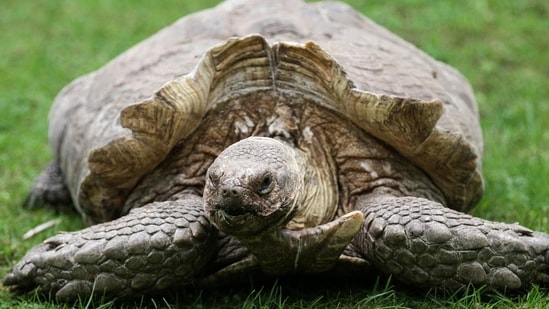Published on Mar 05, 2024 11:45 AM IST
Exotic animals, both trafficked from and to India range from birds to reptiles with ancient lineage, and mammals, undermining decades of conservation efforts.
/

View Photos in a new improved layout
Published on Mar 05, 2024 11:45 AM IST
African Spur Thighed Tortoise. India, with its abundant biodiversity and strategic geographic location, serves majorly as a destination and sometimes as a source for trafficked exotic species. (Photo by Neil D’Cruze)
/

View Photos in a new improved layout
Published on Mar 05, 2024 11:45 AM IST
Monitor Lizard (Varanus). According to the Wildlife Crime Control Bureau (WCCB), the period from 2011 to 2020 witnessed approximately 140 seizures of live exotic wildlife species. (Photo by Neil D’Cruze)
/

View Photos in a new improved layout
Published on Mar 05, 2024 11:45 AM IST
Monitor Lizard – Hatha Jodi. Exotic species are non-native animals or plants introduced into new environments, often causing ecological, economic, or health impacts on their adopted ecosystems.(Photo by Neil D’Cruze)
/

View Photos in a new improved layout
Published on Mar 05, 2024 11:45 AM IST
Star Tortoise. The smuggling of native species of India to other countries includes mostly turtles and tortoises, according to the Wildlife Crime Control Bureau (WCCB). “The Indian Star Tortoise is notably the most trafficked species in this illegal trade,” said HV Girisha, director, WCCB – India’s apex body to deal with wildlife crime.(Photo by Neil D’Cruze)
/

View Photos in a new improved layout
Published on Mar 05, 2024 11:45 AM IST
Star Tortoise (shell detail). (Photo by Neil D’Cruze)
/

View Photos in a new improved layout
Published on Mar 05, 2024 11:45 AM IST
Green Macaw. In the avian world, the exotic trade sees the Green and Blue Macaw and Copper Teal being smuggled across borders. (Photo by Jay)
/

View Photos in a new improved layout
Published on Mar 05, 2024 11:45 AM IST
Ball Python. “Exotic pet trade is all about getting what is non-native and rare into a country where the owner can show off with the animal,” said Jose Louies, joint director and chief of wildlife crime control, Wildlife Trust of India. (Photo by Neil D’Cruze)
/

View Photos in a new improved layout
Published on Mar 05, 2024 11:45 AM IST
Blue Iguana. The routes used for illegal trafficking are as complex as they are covert. Smugglers exploit porous borders, leveraging land and air pathways to transport these animals across continents. (Photo by Neil D’Cruze)
/

View Photos in a new improved layout
Published on Mar 05, 2024 11:45 AM IST
Blue and Yellow Macaw. In the realm of air trafficking, the dynamics shift towards using the vast network of international flights to move contraband. This method of trafficking is particularly chosen for smuggling a variety of species, including ball pythons, cockatoos, capuchin monkeys, iguanas, kangaroos, macaws, and marmoset monkeys.(Photo by Neil D’Cruze)
/

View Photos in a new improved layout
Published on Mar 05, 2024 11:45 AM IST
Pangolin. The impact of this trade is profound and multifaceted. Beyond the immediate threat to the survival of these species, trafficking of exotic species undermines conservation efforts, disrupts ecosystems, and can introduce invasive species that threaten local wildlife. (Photo by Neil D’Cruze)
/

View Photos in a new improved layout
Published on Mar 05, 2024 11:45 AM IST
Marmoset Money. The close contact between humans and these wild animals during capture, transport and sale increases the risk of zoonotic diseases, which can lead to epidemics and pandemics.(Photo by Matt Flores)
/

View Photos in a new improved layout
Published on Mar 05, 2024 11:45 AM IST
